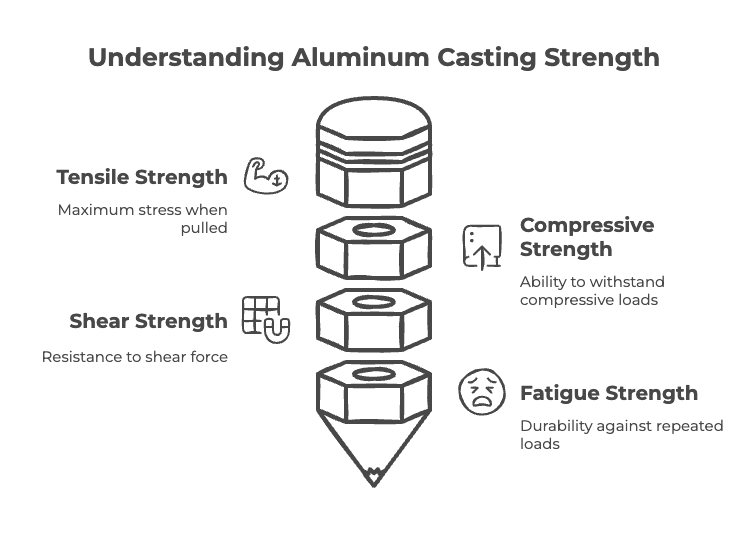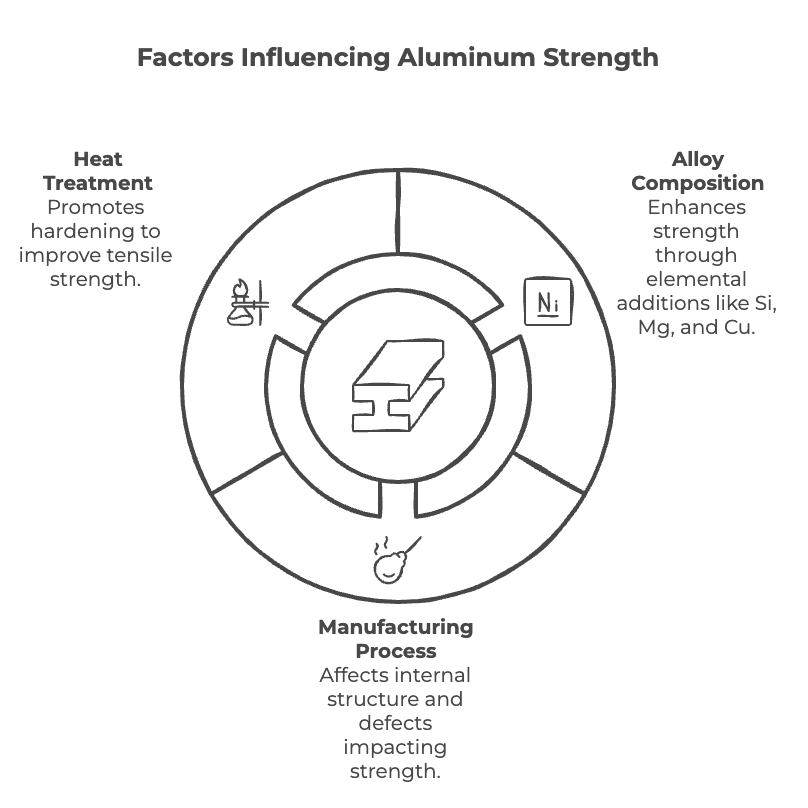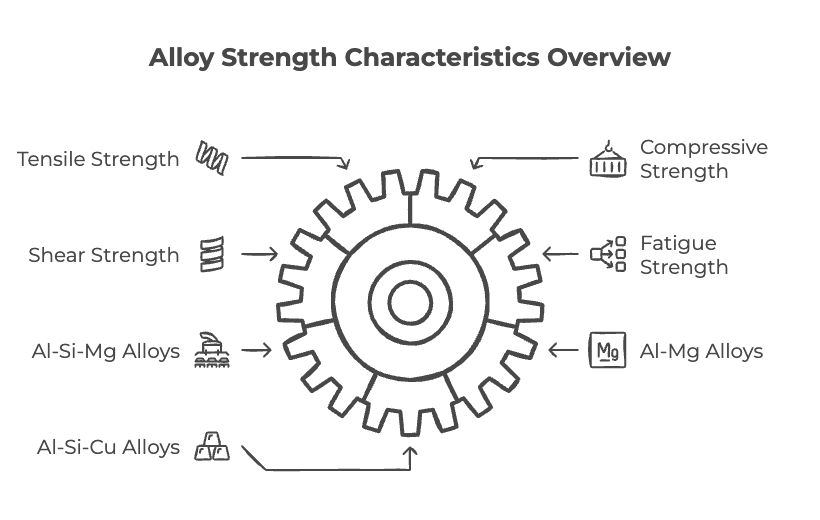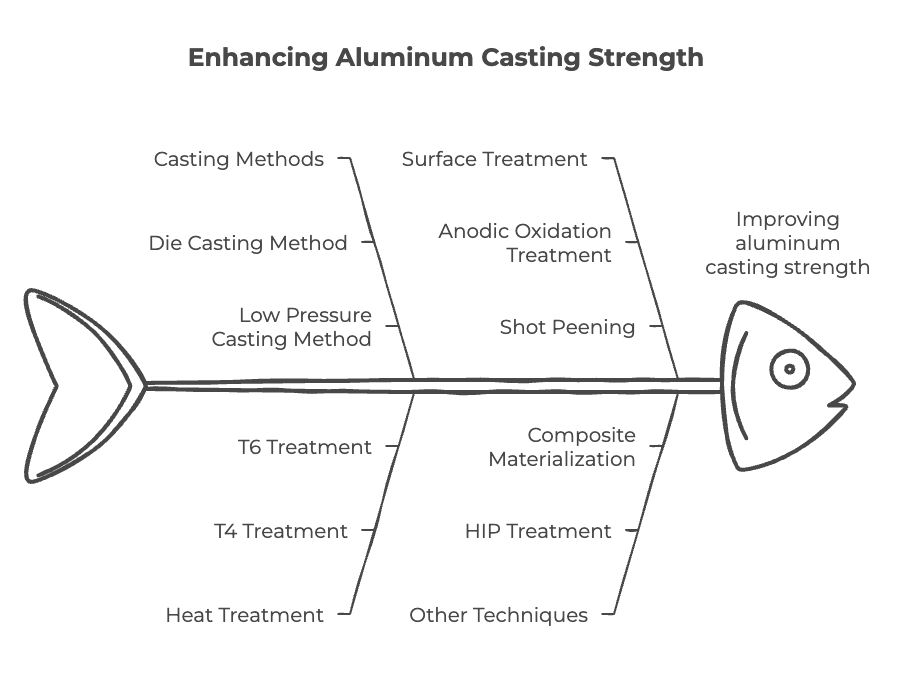◆Table of contents
ToggleIntroduction: What is Aluminum Casting?
Aluminum casting is a manufacturing process where molten aluminum alloy is poured into a mold, allowed to cool and solidify, and then ejected. Aluminum is about one-third the weight of iron, and thus, using aluminum castings can significantly contribute to weight reduction of the overall product. It is lightweight yet possesses high strength, and is also excellent in workability, corrosion resistance, and thermal conductivity, making it suitable for a wide range of applications such as automobiles, aircraft, industrial machinery, and construction materials.
In the automotive industry, aluminum castings are used for engine blocks, cylinder heads, wheels, transmission cases, and other parts, contributing to improved fuel efficiency and vehicle performance. In the aerospace industry, they are used for structural components, engine parts, interior parts, and more, achieving both lighter aircraft and increased structural strength. For industrial machinery, aluminum castings are used in gears, housings, pump components, valves, and other parts, improving the performance of the machinery itself. In construction, they are used for window frames, doors, handrails, exterior materials, and other applications, contributing to the aesthetic appeal and durability of buildings.
This article focuses on the strength characteristics of aluminum castings and the importance of selecting the optimal material. It provides a guide to help you choose the best aluminum casting for your specific application. We will cover the strength characteristics of aluminum castings, factors affecting their strength, the types and properties of representative aluminum casting alloys, the selection of appropriate aluminum casting materials for various applications, and techniques for improving the strength of aluminum castings.
Basic Knowledge of Aluminum Casting Strength
Strength Characteristics of Aluminum Castings
Strength refers to a material’s ability to resist external forces without breaking. The strength characteristics of aluminum castings are extremely important for ensuring the safety and durability of products. Aluminum castings mainly have the following four strength characteristics.
- Tensile Strength: The maximum stress a material can withstand when pulled. Tensile strength indicates how much force a material can be pulled with before it breaks.
- Compressive Strength: The ability of a material to withstand compressive loads. Compressive strength indicates how much force a material can be pushed with before it deforms.
- Shear Strength: The ability of a material to withstand shear force. Shear strength indicates how much force a material can be sheared with before it breaks.
- Fatigue Strength: Durability against repeated loads. Fatigue strength indicates how much repeated load a material can withstand before it breaks.
These strength characteristics vary greatly depending on the type of alloy, manufacturing process, and heat treatment conditions.
Factors Affecting Strength
The strength of aluminum castings is influenced by various factors. The main factors include the following:
- Alloy Composition: Adding elements such as silicon (Si), magnesium (Mg), and copper (Cu) to aluminum improves its strength. For example, Al-Si-Mg alloys have high strength and corrosion resistance. Alloy composition is a major factor that greatly affects the strength properties of aluminum castings.
- Manufacturing Process: Casting methods such as sand casting, die casting, and investment casting result in different internal structures and presence or absence of defects in the casting, which affects the strength. Die casting injects molten aluminum into the mold at high speed, so the structure tends to be finer and higher strength can be obtained.
- Heat Treatment: Heat treatment such as T4 or T6 treatment promotes precipitation hardening and improves strength. In particular, T6 treatment significantly improves tensile strength. Heat treatment is an important process for adjusting the strength of aluminum castings.
Strength Measurement Methods
The strength of aluminum castings is evaluated by the following tests based on JIS standards.
- Tensile Test: A test piece is pulled, and the stress until it breaks is measured. The tensile test is performed to measure the tensile strength and elongation of the material.
- Hardness Test: The Brinell hardness test is commonly used. The hardness test measures the surface hardness of the material. Hardness is used to evaluate the wear resistance and press-fitting properties of the material.
These test results serve as important indicators for quality control and material selection of aluminum castings.
Types and Strength Characteristics of Aluminum Casting Alloys
Typical Aluminum Casting Alloys
There are many different alloys used for aluminum castings, each with unique characteristics and applications. Here is an overview of the typical aluminum casting alloys, their properties and main uses:
| Alloy Name | Main Components | Characteristics | Main Applications |
|---|---|---|---|
| AC4C | Al-Si-Mg based | High corrosion resistance and strength, heat treatable | Automotive parts (cylinder heads, engine blocks), building materials |
| AC7A | Al-Mg based | Excellent corrosion resistance and toughness | Marine parts, food processing machinery parts |
| ADC12 | Al-Si-Cu based | High castability and tensile strength | Automotive parts (die-cast parts), electrical equipment parts |
| AC4CH | Al-Si-Mg based | Higher strength and elongation than AC4C | Automotive parts (wheels), aircraft parts |
| A356 | Al-Si-Mg based | High strength, good castability | Aircraft parts, turbine parts |
In addition to the above, there are various other aluminum casting alloys such as AC2A, AC3A, AC4B, and AC8A. Each of these alloys have different properties, and the optimal one is selected depending on the intended use.
Comparison of Strength Characteristics
The strength characteristics of aluminum casting alloys are evaluated by tensile strength, compressive strength, shear strength, fatigue strength, and others. These strength characteristics vary depending on the alloy’s composition, manufacturing process, and heat treatment conditions.
Generally, Al-Si-Mg alloys (such as AC4C, AC4CH, A356) have high strength and corrosion resistance, and their strength can be further increased by heat treatment. On the other hand, Al-Mg alloys (such as AC7A) are excellent in corrosion resistance and toughness, but their strength tends to be lower than that of Al-Si-Mg alloys. Al-Si-Cu alloys (such as ADC12) have excellent castability, but their strength and corrosion resistance may be lower compared to other alloys.
When comparing the strength characteristics of each alloy, it is important to pay attention to the following points:
- Tensile Strength: The maximum stress that a material can withstand when pulled.
- Compressive Strength: The ability of a material to withstand compressive loads.
- Shear Strength: The ability of a material to withstand shear force.
- Fatigue Strength: Durability against repeated loads.
These strength characteristics differ depending on the application. For example, high-temperature strength is required for automobile cylinder heads, and high strength and light weight are required for aircraft structural members.
It is important to compare and consider the advantages and disadvantages of each alloy and select the optimal alloy according to the application.
Selection of Aluminum Casting Materials by Application
Selecting aluminum casting materials is an important process that greatly affects the performance and cost of the product. Here, we will explain the characteristics required for each application and the selection of the optimal aluminum casting material.
Automotive Parts
Automobile parts require various characteristics such as light weight, strength, heat resistance, and corrosion resistance.
- Engine Block, Cylinder Head: Al-Si-Cu alloys (such as ADC12) are often used because high strength, heat resistance, and wear resistance are required under high temperature environments.
- Wheel: Al-Si-Mg alloys (such as AC4CH) are often used because light weight, strength, and durability are required.
- Transmission Case: Al-Si-Mg alloys (such as AC4C) are often used because light weight, strength, and vibration damping are required.
Aircraft Parts
Aircraft parts are required to have high strength, light weight, corrosion resistance, heat resistance, and the like.
- Structural Members: Al-Cu alloys or Al-Zn alloys are used because high strength and light weight are required.
- Engine Parts: Ni-based superalloys or Ti alloys are used because high strength and heat resistance are required under high temperature environments.
Industrial Machinery Parts
Industrial machinery parts are required to have strength, durability, wear resistance, corrosion resistance, and the like.
- Gears, Shafts: Al-Si-Mg alloys or Al-Cu alloys are used because high strength and wear resistance are required.
- Housings, Frames: Al-Si-Mg alloys or Al-Zn alloys are used because high strength and rigidity are required.
Building Materials
Building materials are required to have corrosion resistance, designability, workability, recyclability, and the like.
- Window Frames, Doors: Al-Mg alloys (such as AC7A) are often used because corrosion resistance and designability are required.
- Exterior Materials: Al-Mg alloys or Al-Si alloys are often used because corrosion resistance, designability, and workability are required.
Other Applications
In addition to the above, aluminum castings are used in various fields such as electrical equipment parts, medical equipment parts, and daily necessities. The required characteristics and optimal materials differ depending on the application.
Points for Material Selection
When selecting aluminum casting materials, it is necessary to consider the following points.
- Application: What kind of product will it be used for?
- Required Characteristics: What kind of characteristics are required, such as strength, heat resistance, corrosion resistance, and light weight?
- Cost: Consider material costs, processing costs, etc.
- Manufacturing Process: What kind of casting method will be used for manufacturing?
It is important to comprehensively judge these factors and select the optimal aluminum casting material.
Aluminum Casting Strength Improvement Techniques
Various techniques are used to improve the strength of aluminum castings. Here, we will explain typical strength improvement techniques and their effects.
Improvements in Casting Methods
The strength of aluminum castings can be improved by devising casting methods.
- Die Casting Method: Because molten aluminum is injected into the mold at high speed, the structure is easily refined and high strength can be obtained. In addition, the casting cycle is short and it is suitable for mass production.
- Low Pressure Casting Method: Because molten aluminum is injected into the mold at low pressure, the flow of the molten metal is good and castings with few defects can be obtained. This improves the strength.
- Sand Casting Method: Although it is suitable for castings with complex shapes, the cooling rate is slow, so the structure tends to be coarse and the strength tends to be low. However, even with the sand casting method, the strength can be improved by devising the mold material and casting conditions.
Heat Treatment
Heat treatment is an important process for adjusting the strength of aluminum castings.
- T4 Treatment: The strength is improved by solution treatment and then natural aging. It is mainly applied to Al-Si-Mg alloys.
- T6 Treatment: The strength is further improved by solution treatment and then artificial aging. Higher strength can be obtained than with T4 treatment, but dimensional changes tend to be larger.
- Other Heat Treatments: It is also possible to improve properties other than strength (such as toughness and corrosion resistance) by combining various heat treatments such as annealing and tempering.
Surface Treatment
Surface treatment is performed to improve the surface hardness and corrosion resistance of aluminum castings.
- Anodic Oxidation Treatment: By forming an oxide film on the surface of the aluminum casting, corrosion resistance, wear resistance, and insulation are improved. It is also possible to color it.
- Shot Peening: By colliding fine spherical metal particles with the casting surface at high speed, compressive stress is generated on the surface and fatigue strength is improved.
- Coating: By applying various coatings such as painting and plating, corrosion resistance, wear resistance, and designability can be improved.
Other Strength Improvement Techniques
In addition to the above, there are the following strength improvement techniques.
- HIP treatment (Hot Isostatic Pressing): By treating the casting under high temperature and high pressure, internal defects are reduced and strength is improved.
- Composite Materialization: The strength is improved by combining reinforcing materials such as fibers and particles with the aluminum casting.
Selection of Strength Improvement Techniques
In order to improve the strength of aluminum castings, it is necessary to select the optimum technology according to the application and required characteristics of the product. For example, the die casting method is suitable for automobile parts because it can achieve both high strength and productivity. T6 treatment is effective when high strength is required, but dimensional changes must also be considered. Surface treatment is effective for improving corrosion resistance and surface hardness.
Higher strength can also be obtained by combining multiple strength improvement techniques. For example, high-strength automobile parts can be manufactured by combining the die casting method and T6 treatment.
Q&A Regarding the Strength of Aluminum Castings
- Q: How does the strength of aluminum castings compare to that of iron castings?
- A: Aluminum castings are lighter than iron castings, but generally have lower strength, especially tensile strength and heat resistance. However, it is possible to increase the strength through heat treatment and alloying. For example, by T6 treating an Al-Si-Mg alloy, it is possible to obtain strength close to that of iron castings. However, iron castings are generally superior in high-temperature strength and wear resistance.
- Q: Which alloy is suitable for use in high-temperature environments?
- A: When using in a high-temperature environment, Al-Si-Cu alloys (e.g., ADC12) are suitable. ADC12 has excellent high-temperature strength and can maintain relatively high strength even at high temperatures. Heat-resistant aluminum alloys to which elements such as Ni and Cr are added to enhance heat resistance are also used.
- Q: What are some ways to improve the strength of aluminum castings?
- A: There are various ways to improve the strength of aluminum castings, such as devising the casting method, heat treatment, and surface treatment. The die casting method allows for high strength to be obtained by miniaturizing the structure by rapid cooling. In addition, T6 treatment can significantly improve the strength by precipitation hardening. Anodic oxidation treatment and shot peening are effective in improving surface hardness and fatigue strength.
- Q: What measures are effective in improving the fatigue strength of aluminum castings?
- A: The following measures are effective in improving the fatigue strength of aluminum castings:
- Selection of casting method: The die casting method tends to have a finer structure and higher fatigue strength.
- Heat treatment: T6 treatment improves fatigue strength by precipitation hardening.
- Surface treatment: Shot peening generates compressive stress on the surface and improves fatigue strength.
- Shape design: Fatigue strength can be improved by designing the shape to avoid stress concentration.
- Q: What should I do if I am unsure about selecting the material for aluminum casting?
- A: If you are unsure about selecting the material for aluminum casting, we recommend consulting with a specialist or a casting manufacturer. Experts will suggest the optimal material and manufacturing process according to the product’s application and required characteristics. In addition, you can select the optimal material by considering the strength characteristics, cost, delivery date, etc. of the material.
Summary
Aluminum castings are widely used in various fields due to their excellent properties, but their strength characteristics are greatly affected by various factors such as the type of alloy, manufacturing process, and heat treatment.
Choosing the right material is very important to maximize the performance of the product. Consider not only strength but also cost and manufacturability, and select the optimal aluminum casting for the application.
If you are unsure about material selection, we recommend consulting with a specialist or a casting manufacturer. Experts will suggest the optimal material and manufacturing process according to the product’s application and required characteristics.
We hope that this article will deepen your understanding of the strength characteristics and material selection of aluminum castings, and help you choose the best material.




